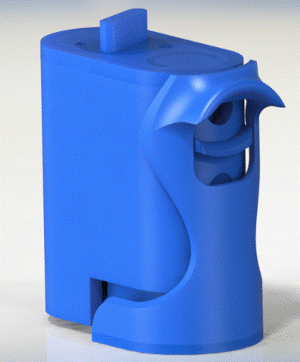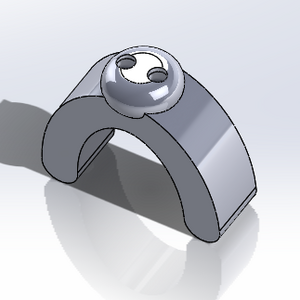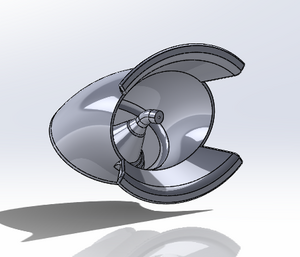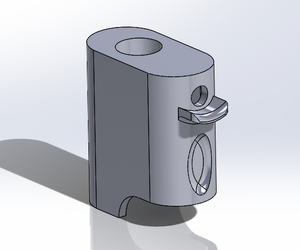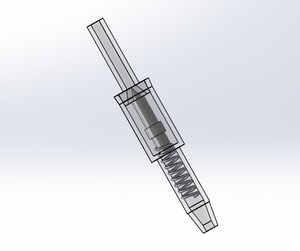Eye Medication Applicator
Our goal is to design, fabricate, and test a product that will effectively deliver medication to the eye in a way that will appeal to a wider audience than products currently on the market.
| The latest complete prototype as of October 2014 | |
| Team Name | Vision Quest |
| Team Members |
|
| Sponsors | |
| Faculty Advisors |
|
| Project Period | Summer 2014 - Fall 2014 |
Design Specifications
Our product must follow a number of guidelines
- Each application must deliver 0.5 mL of medication to the eye
- At least 90% of the medication must make direct contact with the eyeball
- The product must be usable for the average person between the ages of 8-85
- The applicator must be compatible with all prescription eye-dropper bottles
- The bottle will not be manually squeezed during use
- The user will not have to tilt their head back more than 10 degrees during use
- The user will not have to move their shoulder more than 15 degrees from resting position during use
- The user will not have to flex the ends of their fingers to more than 135 degrees inward from a straightened position
- The average user must be able to change bottles within 15 seconds
Project Learning
The aim of our project is to solve problems related to the application of eye medication. We looked at any and all problems that may arise in using eye drops and narrowed our focus to four main issues. While these are all deemed important to our goals, not all of them will receive the same focus. These problems are ranked from most relevant to least relevant within our project goals.
- [Most Relevant] Lack of dexterity with users such as lack of neck and shoulder dexterity and inadequate fine motor skills
- Wasted medication as a result of inaccuracy or inappropriate dosage
- Inconsistent application approach as a result of ill-defined application methods for current products and misuse of products
- Undesirable reflexes such as anticipation, blinking, and uncooperative behavior
Design Ideas
In the early stages of our project, we designed and printed a number of prototypes with different goals in mind. Each design has unique functions as well as advantages and disadvantages. Our current design utilizes and improves upon features from other prototypes such as the three listed below.
| Picture | Description | Pros/Cons |
|---|---|---|
| Angled Applicator
This was our first printed design. The purpose of this design was to remove head tilt from eye-drop application. To use it, the user tilts their back 45o and holds the cup over their eye. |
Advantages:
Disadvantages:
| |
| Nose-fitted Guide
This design was focused toward making the product as simple as possible. The applicator was worn on the bridge of the nose. The medication would be dropped into each hole corresponding to the left and right eye. Holes on the ends of the device would then drip medication into the inner corner of each eye. |
Advantages:
Disadvantages:
| |
| Angled Applicator with Nozzle
This design revisits concepts from our first angled applicator. The eye cup helps keep the eye open and the nozzle allows the medication to squirt into the eye. |
Advantages:
Disadvantages:
|
Detailed Design
Our design consists of three major components - the casing, the button/head, and the internal pump and nozzle. The piping and nozzle are not shown, but the pump drives flow through the nozzle. The current nozzle was adopted directly from a commercial product - the final product will have a custom-made nozzle. The casing, button, and head will be injection molded from a soft polyurethane plastic with the internals positioned within the plastic as it sets.
| Picture | Needs | Specifications | Design Features |
|---|---|---|---|
|
|
| |
|
|
| |
|
|
|
Current Design
Our current design is a modification of a previous model which can now be molded with polyurethane and silicon. An experimental mold has been completed as a proof-of-concept. The mold template was prepared using a 3D print of this design.
The design consists of multiple components:
- A casing that holds the rest of the components in place
- A button piece that slides into the casing, actuating the pump
- A pump that delivers a mixture of air and fluid to the nozzle
- A nozzle that delivers a fine and consistent spray (not shown)
- Contouring part that fits against the face (not shown)
